I had high hopes for Diceapalooza but it’s a party I should have skipped
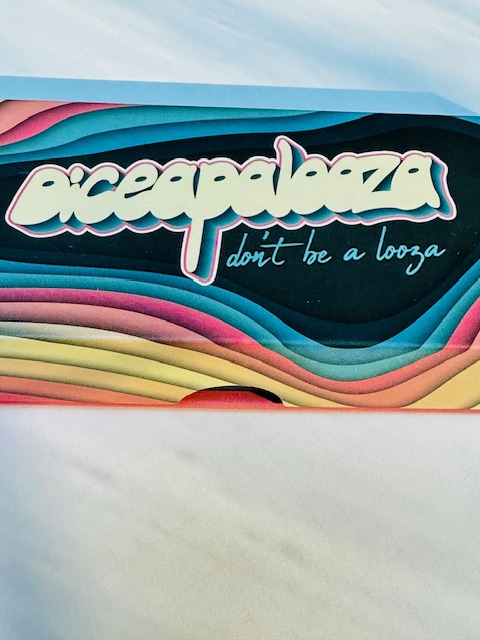
Name: Orange Tibetan Agate stone dice
Description: This is a standard-size set of near-sharp edge stone dice from the “Diceapalooza” Kickstarter campaign from Wyrmwood gaming. They are made from Orange Tibetan Agate stones. They are various shades of orange and white. Some of the dice have striations (stripes) of various thickness / density while others have none. The set are made with very different shapes than the standard 6 shapes that are most commonly used for TTRPG dice. Instead of the standard number of sides per die (in descending order: 20, 12, 10, 10, 8, 6, 4), The dice in this set are what Wyrmwood are calling “Gyroid” shapes and have (again, in descending order: 20, 24, 30, 30, 24, 12, 12) sides. This means that the d12 has 24 sides, and the d10s have 30 sides each, etc…. The dice are all very much more rounded shapes that will roll farther and in Wyrmwood’s opinion be more random/fair. With more sides than values on all of the dice except for the d20, the values are duplicated. There are three of each value on the 30-sided d10s, two of each value on the 12-sided d6, three of each value on the 12-sided d4 for example. The dice have a gold painted font that looks like a narrow TNR. the 6 and 9 faces use periods to indicate orientation. One of the faces that has the die’s highest value is inked silver instead of gold. (not all of the highest values on that die, just one of them strangely). For example, one of the two faces on the 12-sided d6 has the Wyrmwood shield/tree logo instead of a number. I bought these dice through a Kickstarter campaign. They were available in 16 stone / glass versions and 16 different sharp-edge resin designs. Orange Tibetan Agate was the best looking of all of the stone options by far. None of the resin dice really caught my eye. The prices on these sets were much more reasonable than usual for Wyrmwood and the option of getting something that I’ve never seen before (Gyroid shapes) drew me in.
Also included with my dice was a pin that I will never use, and a separate cheap resin d20 that’s bright (day glow) orange with yellowish-white numbers. It’s a “high variance” d20 so it doesn’t have the standard 1-20 on it’s faces. It has the following numbered faces: 1, 1, 1, 2, 2, 3, 3, 4, 5, 6, 15, 16, 17, 18, 18, 19, 19, 20, 20, 20.
That’s:
Three separate faces with: 1 and 20
Two separate faces each of: 2, 3, 18, and 19
One face each of: 4, 5, 6, 15, 16, and 17
I’ve heard of high variance dice existing but have never seen one until now.
Size:
d20: (Face->Face) 20.65 mm (Point->Point) 25.5 mm
Extra d20: (Face->Face) 20.2 mm (Point->Point) 23.8 mm
Where did they come from: Wyrmwood Gaming (Kickstarter campaign)
How much did they cost: $85
Material / color: Stone, Orange Tibetan Agate / white, orange, black.
Extra d20: Cheap plastic, bright orange with yellow ink
Quality: Very good
Readability: Orange Tibetan Agate dice: Some faces decent, some almost unreadable
Extra d20: excellent. Easy to read from 8+ feet away
Value: Good value for a set of stone dice.
Overall Rating: 7/10
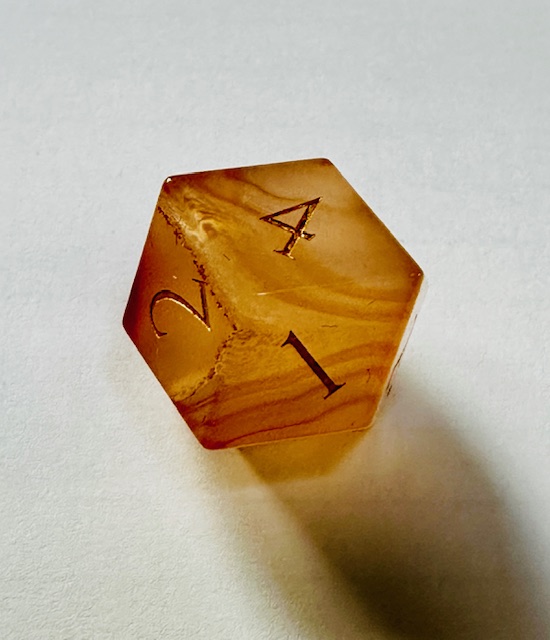
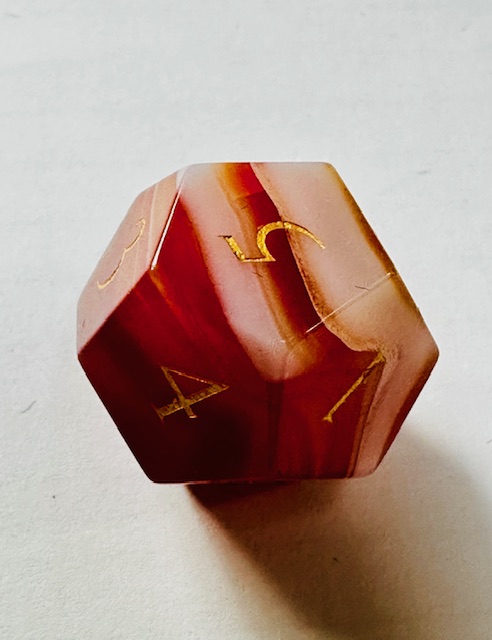
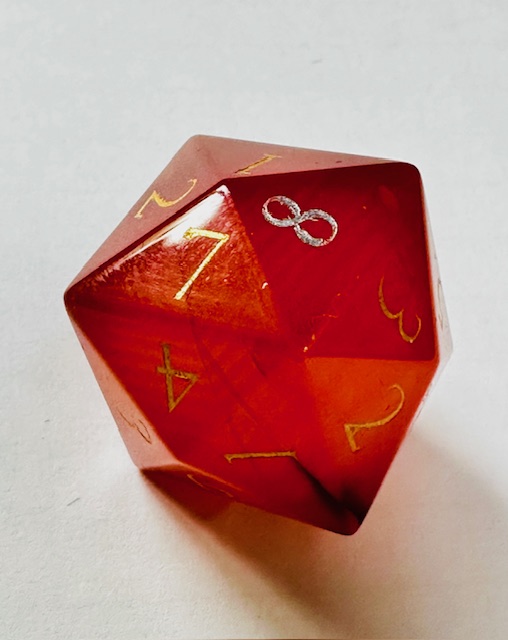
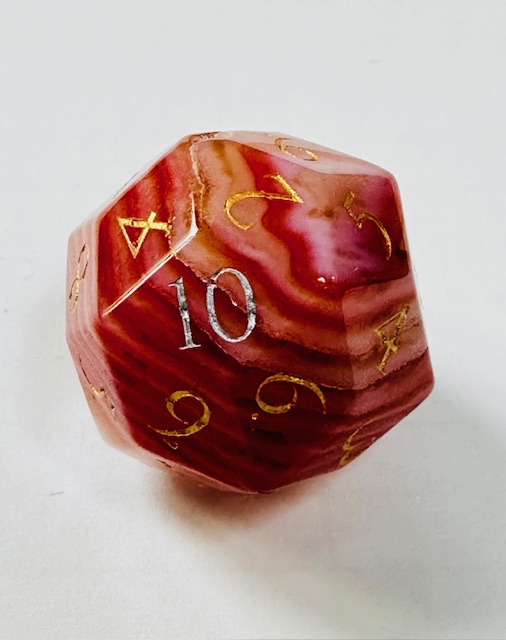
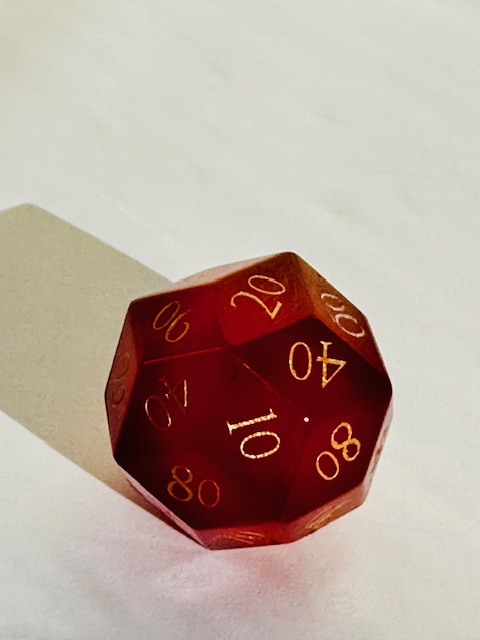
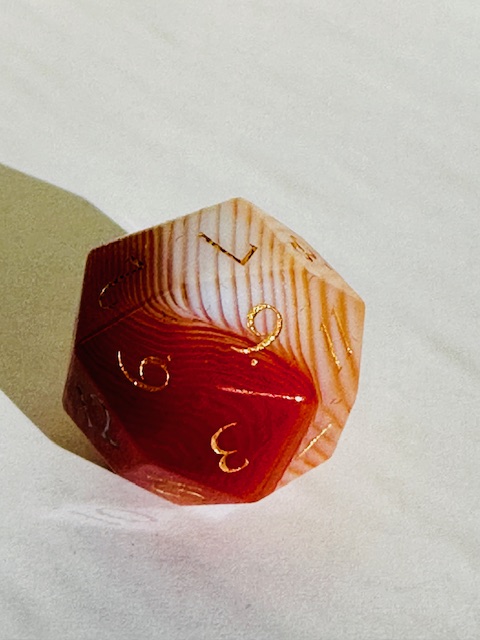


Attempts needed to roll a natural 20:
Orange Tibetan Agate: 75 rolls
High variance d20: 11 rolls
Fifty d20 rolls:
Orange Tibetan Agate d20: 6, 4, 4, 10, 18, 5, 7, 10, 9, 17, 18, 8, 18, 3, 2, 18, 3, 3, 3, 7, 11, 1, 13, 16, 6, 13, 14, 14, 18, 12, 7, 6, 15, 16, 8, 2, 12, 2, 19, 11, 14, 19, 4, 8, 10, 1, 3, 9, 18, 17
Mean: 9.84
Median: 9.5
Mode: 18 (most common)

Bonus high variance d20: 17, 2, 2, 18, 3, 15, 6, 1, 5, 19, 16, 1, 1, 3, 2, 5, 19, 1, 20, 18, 1, 16, 18, 18, 20, 3, 1, 3, 20, 20, 18, 3, 18, 1, 18, 1, 2, 5, 4, 15, 5, 20, 19, 16, 16, 17, 20, 16, 3, 20
Mean: 10.62
Median: 15
Mode: 1 (most common)

4d6 drop 1 stat block: 10, 15, 8, 16, 15, 12 (76 total) A Depressed Tiefling Wizard from the most vile of swamps who has a serious weapons fetish
For reference: the Standard Array method totals to: 72 and the Point Buy method totals to: 69.
Casting Storm of Vengeance (9th level)
A churning storm cloud forms, centered on a point you can see and spreading to a radius of 360 feet. Lightning flashes in the area, thunder booms, and strong winds roar. Each creature under the cloud (no more than 5,000 feet beneath the cloud) when it appears must make a Constitution saving throw. On a failed save, a creature takes 2d6 thunder damage and becomes deafened for 5 minutes.
Each round you maintain concentration on this spell, the storm produces different effects on your turn.
Round 2. Acidic rain falls from the cloud. Each creature and object under the cloud takes 1d6 acid damage. (3)
Round 3. You call six bolts of lightning from the cloud to strike six creatures or objects of your choice beneath the cloud. A given creature or object can’t be struck by more than one bolt. A struck creature must make a Dexterity saving throw. The creature takes 10d6 lightning damage on a failed save, or half as much damage on a successful one. (45, 26, 29, 22, 29, 27). – these were almost all complete shit rolls…
Round 4. Hailstones rain down from the cloud. Each creature under the cloud takes 2d6 bludgeoning damage. (10)
Round 5–10. Gusts and freezing rain assail the area under the cloud. The area becomes difficult terrain and is heavily obscured. Each creature there takes 1d6 cold damage. Ranged weapon attacks in the area are impossible. The wind and rain count as a severe distraction for the purposes of maintaining concentration on spells. Finally, gusts of strong wind (ranging from 20 to 50 miles per hour) automatically disperse fog, mists, and similar phenomena in the area, whether mundane or magical. (5)
If this is all directed at one enemy: A total of 196 points of acid, lightning, bludgeoning, and cold damage or 105 points of total damage if all 6 dexterity saves are made for the lightning damage.
(This is another excuse for rolling dice)
Random Tables rolls:
Rare Eberron Gods: 74 – The Gatekeeper – The Gatekeeper is a mysterious god who guards the gateway to the afterlife. It is said that those who pass through the gate must answer three questions posed by the Gatekeeper in order to gain entry. Those who fail to answer correctly are doomed to wander Eberron forever, unable to enter either life or death.
Different Arrow types: 16 – Arrow of Healing – Deals 1d4 damage, heals 1d8 hp.
(I’m getting these random tables at: https://d100tables.com by the way
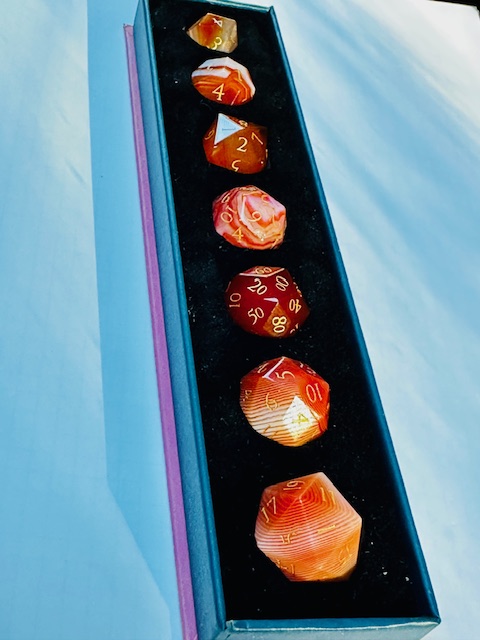
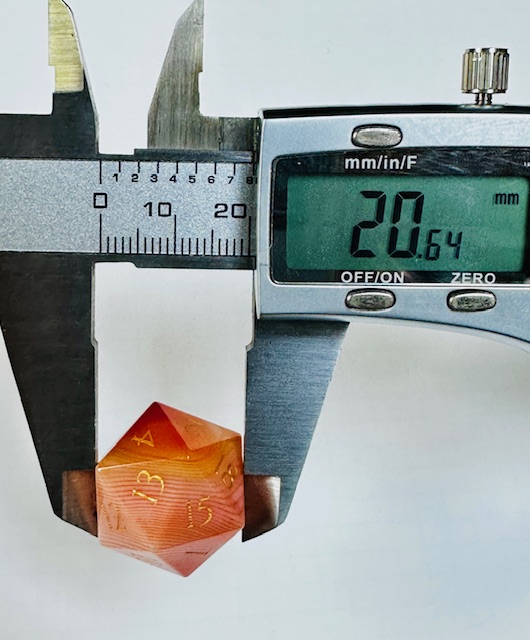
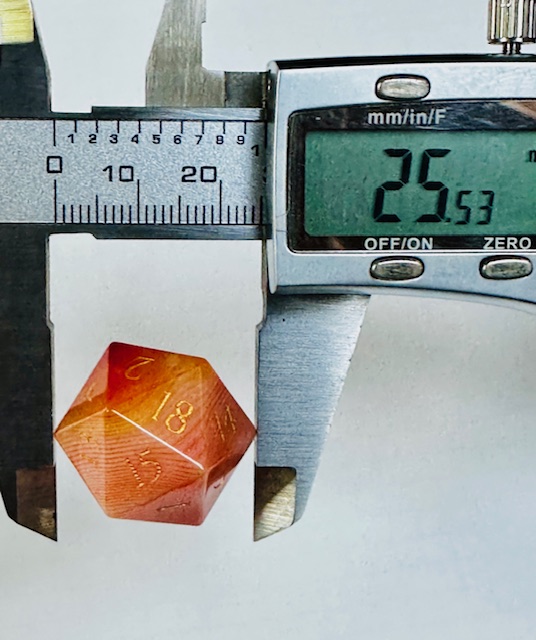

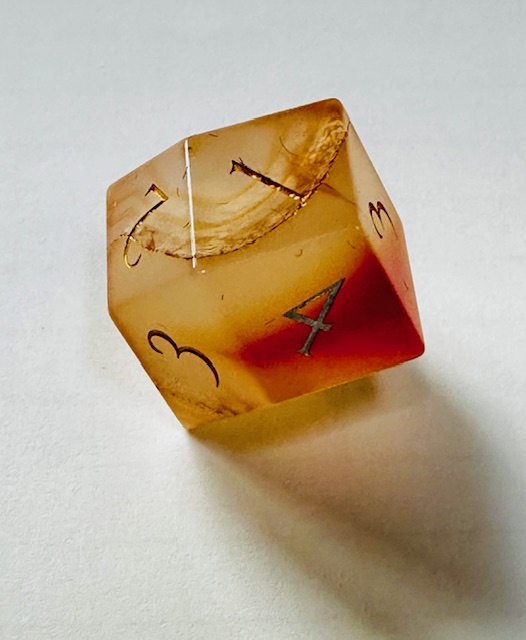
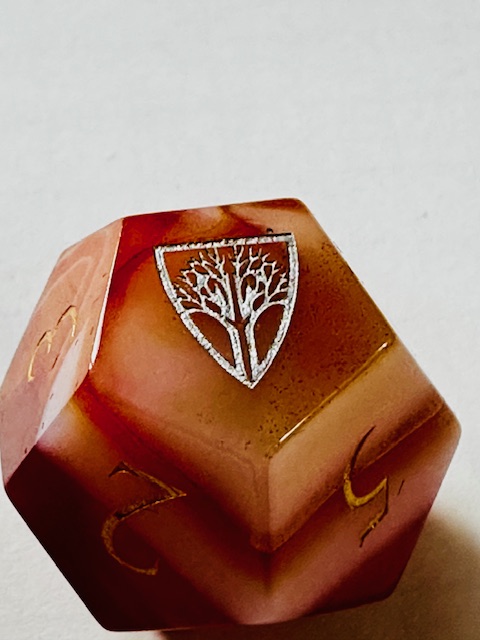
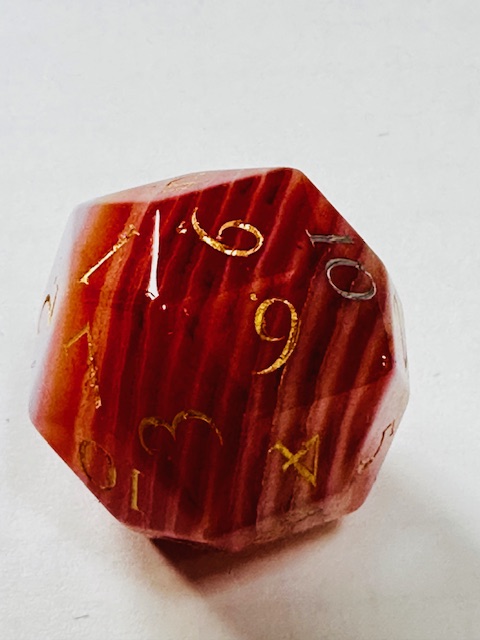
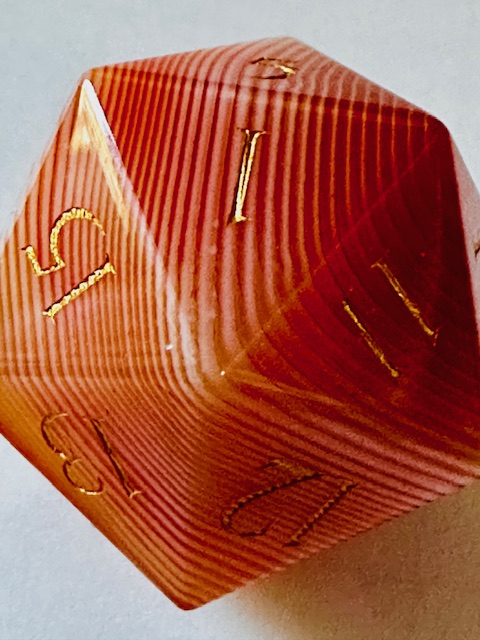
Final Thoughts: (I have many)
I was on the fence with this Kickstarter campaign as Wyrmwood doesn’t have a very good track record with their dice (or pricing them reasonably). I find the company a mixture of good “Yah, support the little guy and buy US-made furniture!” and smarmy (Why is their marketing guy so creepy?). What put me into the “give these dice a try” category was:
1) The look of the Orange Tibetan Agate in the product photos.
2) The ability to get a set of dice in the new “Gyroid” shapes that I’ve never seen before.
3) The cost.
In a break from the norm, Wyrmwood priced these dice at $85 for a set of stone Gyroid dice. That’s actually a pretty good deal for stone dice. Orange Agate dice are also hard to find.
The things that were working against my decision were: The terrible Kickstarter name and marketing campaign “Don’t be a looza”, the awful logo / font they used, and that they were standard sized dice.
I ended up buying them and I have some minor regrets.
So, the Gyroid shapes… From what I saw on Wyrmwood’s Youtube video explaining the Gyroid shapes (“Why Our Dice Are Mathematically PERFECT!”), the goal was to make dice shapes where the angle between any two adjacent faces (Called the “Dihedral” angle) is the same. They also wanted to make shapes that are more rounded and rolled better on the table. This is the whole reason they use to back up the claim that the dice are mathematically perfect.
To explain further… If you think of a d8 or a d10 in a standard set, the (dihedral) angles between some of the faces is wider and some are more narrow. The rest of the dice in a standard set have identical dihedral angles. The standard d4 (triangular pyramid) has identical dihedral angles but they’re so acute that the d4 barely rolls. I get what Wyrmwood were after and I agree that these dice all roll much better than a standard set.
I don’t agree that they’re mathematically perfect though (especially after my 50 roll tests). I think the organization of the number positions on the faces should be taken into consideration. Having recently read about how the guy that runs Flying Horseduck worked on optimizing the number placement for the dice he makes where he was considering vertex sums / half sums and looking at better ways to spread out the numbers around each die instead of just opposite faces = (number of sides +1). I’m getting into the weeds here so I’ll leave it at that. Google “flying horseduck mathematically balanced” to dive deeper. When it comes to dice in general, I like non-standard shapes (and Geometry) so gimme a set of Gyroids regardless of the accuracy of their claim of perfection.
These dice are polished stone, which tend to slide around a lot when rolled on a pad of paper or other low-friction surface. I wish I had room at my D&D table to bring my dice tower and my rolling tray for these and other dice but there’s just not enough space to spread it all out in front of me. (the DM, whose house we play at has a Wyrmwood gaming table with the Wyrmwood player desks for everyone. What is a nerd to do?
I have a bit of a love/hate relationship with stone dice. They can be just gorgeous and have a nice clicky-clacky sound when you shake them together but I rarely use them at the table because they are so fragile and I don’t want to chip them. Maybe I need to just throw caution to the wind and stop trying to save them forever. It makes me think about people who collect super-expensive / rare bottles of wine and then die without drinking the wine because they were saving those rare bottles for a special occasion that never happened. The one exception to this is my frosted diachroic glass dice that glow. That set comes to the table with me every session. Just seeing them sitting there in front of me glowing blue, pink, or yellow puts a smile on my face.
I’m mostly happy with the color and design of these dice. They’re not as orange as the marketing photos showed (they never are) but the striations in the set I got are pretty nice. They range from none at all to very thick, to thinner, to extremely thin. I’m very happy with that distribution. The numbers are colored gold, which is not a color I love on dice, especially when it doesn’t go well with the orange color of the stone. One of the high faces on each die is colored silver. I like this concept but I wish all of the high faces on each die were colored silver. Being Gyroid shapes, some of the dice have multiple high faces. (ie: 3 fours on a 12-sided d4) The 12-sided d6 has a wyrmwood tree/shield logo on only one of the 2 high faces. Unfortunately the dice are only standard size so the detail is somewhat lost in the logo.
The dice came in a nice carrying box where the dense foam cutouts are just a little bit too tight for the dice which makes them hard to set in there. The art on the box is gaudy (is that on purpose?) and the font is awful but for a cardboard dice box it’s pretty decent otherwise. The dice came with a free pin (as in button-it-onto-your-clothes to show your love for the Diceapalooza campaign) but it’s also gaudy and will go to someone else or into the trash.
Final thoughts: I find that the more I roll these dice, the more I’m disappointed in how they roll and how hard it is to see the numbers on them. The font is just too delicate which means I’ll probably never take them out of storage and bring them to the table. It frustrates me when companies try to make something nice and then skip the most basic things (making the dice even remotely easy to read)
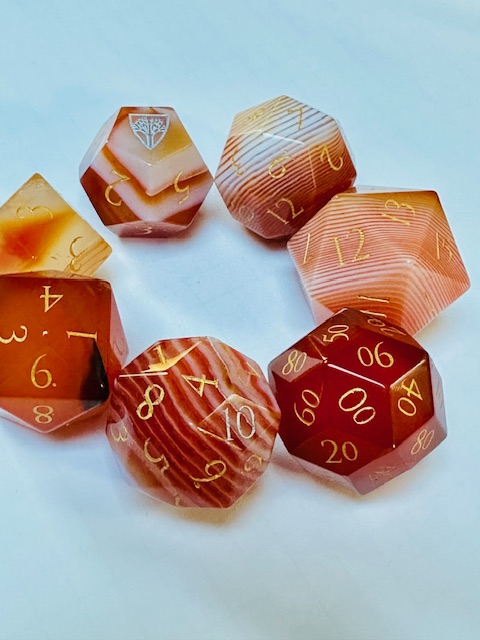
Leave a Reply